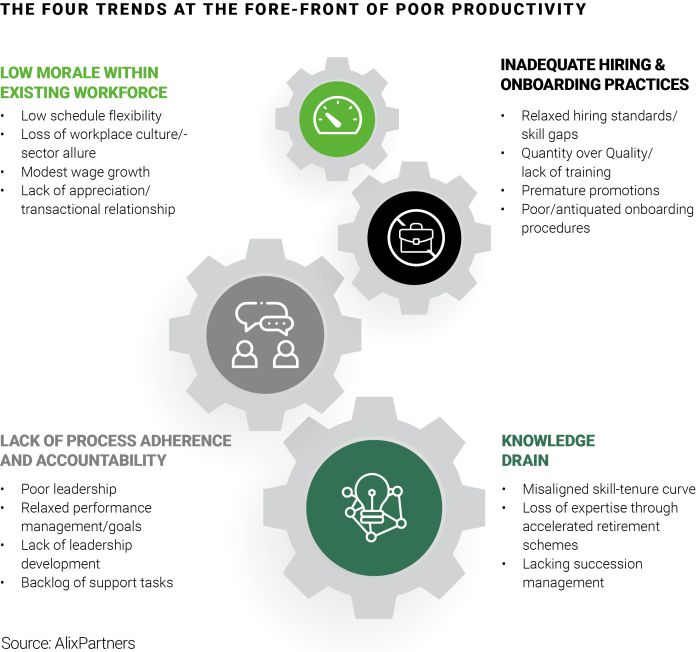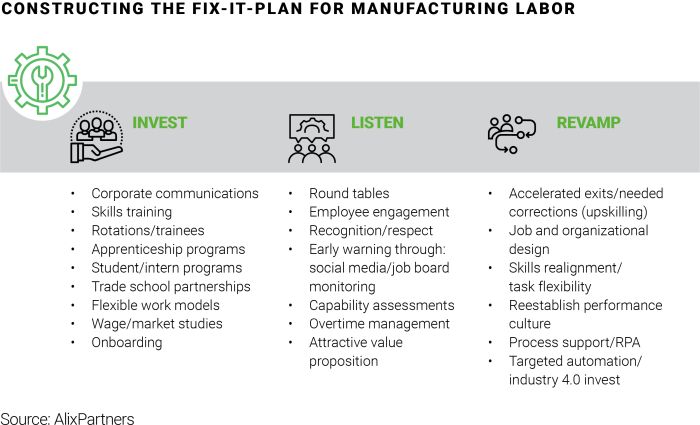Over the past few years, America's factory talent pool has regularly made front-page news. These workers played a central role in political debates about trade agreements and domestic manufacturing. Then, the pandemic underscored the essential nature of production work in the U.S. economy. Subsequent component shortages and onshoring trends only solidified their importance.
Currently, labor unrest is a front-burner issue -- nearly two dozen work stoppages have been called in 2023 through mid-September, resulting in a cumulative of 576 days idle.
These strikes didn't emerge from thin air. Talent is scarce at a time when wages are thought to be insufficient. Technology threatens to displace tasks or eliminate entire job categories. Uncertainty among hourly workers is easy to understand.
These employees, however, aren't the only ones who are discontent. Companies are scrambling as productivity slips, soaring costs erode margins, customers see longer lead times, and entire value chains reorganize amid geopolitical tension, decarbonization, and supply-chain disruption. Managers wonder if today's factory worker is up to the challenge.
The short answer is "no." Not only do many hourly workers lack the skills necessary for a new manufacturing era that is increasingly fueled by digital tools and automation, but they also lack the support required to up their game. The blame, however, belongs to the organization.
This inflection point represents an enormous opportunity. To understand how to solve it, the problem must first be fully diagnosed. We see four major trends to understand:

Low morale within existing workforce
Management is often the last to know they have a morale problem on the factory floor. Because the rush to maintain production schedules, trim costs, and keep an operation humming is constant, it is often easier to ignore problems – that is, until they erupt.
One Texas-based software firm did what every manufacturing company needs to do, surveying hundreds of production workers to gain a pulse on retention. A majority said they plan to leave their job this calendar year, citing wages, a lack of flexibility and free time, and outdated facilities as reasons. Separately, many employees have bemoaned the loss of work-life balance and engagement in their jobs. The workplace today can feel extremely transactional.
Among the key trends weighing on morale is compensation. Because wages are relatively modest in factory settings, workers tend to be disproportionately exposed to the pressure. Over the past 20 months, year-over-year price inflation has averaged more than 6%. Paychecks have indeed gotten fatter over this period as inflation is cooling, but inflation-adjusted wages have fallen 2% since January 2020.
Importantly, not all employees are on equal footing. " Switchers," or those willing to leave one employer for another, routinely earn more and even receive sign-on bonuses. Legacy employees don't necessarily get the same treatment. Another trend that factory workers lose out on is the widespread migration to Work-From-Home and hybrid schedules.
Inadequate hiring and onboarding practices
In an era when talent is hard to find and reluctance to switch increases, more attention can unfortunately be paid to finding anybody rather than finding the right body. Even before the pandemic, employers showed increased willingness to relax hiring standards, and recent studies indicate there has been a further erosion in talent strategies as the labor market further tightened.
Consider the fact that hiring processes have often not been updated in a half-century, leading to unnecessarily lengthy interviewing processes that are reactive and not designed for high-volume hiring – coupled with poor or no adaptation of hiring practices to local circumstances, direct competition, and in-direct competition.
Once these employees are in the door, the problem can be accelerated by poor onboarding routines. In our work, we've encountered employees who have been on the job for one month and are still using a coworker's credentials because he hadn't received their own. Credential-sharing can be commonplace and becomes a major problem when no one knows who to approach about fixing the inevitable headaches this causes.
Covid culture, lack of accountability and process
The pandemic changed work as we know it, but not all for the better. Many employers have no standards for measuring performance beyond daily targets. Accountability and follow-up are lacking, expectations are unclear, and coaching is absent. Coupled with relaxed standards due to fear of attrition during the pandemic, these practices have now hardened into the new "factory culture" at many of our clients are hard to undo.
This is a focus area worth digging a little deeper into. In addition to bad hiring practices, these trends have emerged:
- A lack of performance discipline
- Insufficient labor cost management
- Decaying management systems
- Premature promotions, which widens management skill gaps)
- Unwillingness to prioritize training and feedback
Knowledge leak
These problematic trends come as older talent leaves the workforce with no plan to return and no strategy to pass on their institutional knowledge to a younger generation. We noted in part one of this series ("These Labor Pains aren't Temporary") that a quarter of manufacturing workers are at least 56 years old, and very few have not shared critical information with younger peers.
This is a critical task in an era when generational attitudes toward manufacturing continue to change. Production jobs are often seen as being solely in undesirable "Rust Belt" environments, requiring lower skills than professional roles and offering fewer growth opportunities. Manufacturers need advocates willing to vocalize the value of pursuing a manufacturing career.

Invest
Addressing these issues is a complex and elaborate challenge, but it begins with one critical word: Investment. Employees need to not only be retained, they need to be coached and upskilled. A key motivator for existing team members is the opportunity to pursue clearly articulated advancement opportunities, which include network and culture-building, often facilitated by rotational programs that were widely halted during the pandemic. These must overcome budget-cutting activities in order to be reestablished.
Competitive wages and benefitsstrategies that address complaints about work-life balance. Competitive wages do not always result in higher costs – what should be explored are flexible and part-time models that can create non-monetary benefits and allow retention of experienced skilled labor that seeks to reduce hours.
represent another frontier. Constructing frequent market comps – not only against competitors but other industries that might attract existing employees. Look at best practices across the corporate landscape, including
These investments start from Day One. Frictionless, rapid, and comprehensive onboarding is required in today's digital era, bringing employees up to speed quickly and integrating them into the fabric of the organization.
Finally, and perhaps most importantly, programs need to be initiated to attract more women to the workforce. Females make up about 47% of the American workforce, but only 30% work in manufacturing.
Listen
Today's workforce is anything but passive. Regardless of role, employees seek meaning and engagement. Too often, we encounter front-line workers who feel ignored, overlooked, or badly prepared to do their jobs. When coupled with the widening skill gap in lower managerial positions, the "employee engagement conduit" is clogged.
All-hands meetings or more personable roundtables with plant management and employees can be incredibly valuable in facilitating the interchange with the hourly workforce, feeling the pulse, and creating a stronger feeling of belonging, being heard, and being respected.
HR departments, more than ever, need to plug into social media communities where the company is being discussed. Real-time monitoring of job boards, Facebook groups, and other online water coolers is essential. This supplements but doesn't replace the in-person roundtables and one-on-one meetings that need to be part of everyday factory life and can be the difference-maker in stopping vs. accelerating a plant's negative performance spiral.
When an employee departs, meanwhile, meaningful exit interviews help managers understand top reasons and develop mitigation plans for reducing turnover and take corrective actions.
Revamp
For most organizations, Covid and associated disruptions changed the rules of the game. However, for many companies, the post-pandemic era has simply been seen as an opportunity to go back to business as usual. This is a recipe for letting a crisis go to waste.
Now is the time to revamp existing processes, update systems, and identify ways to eliminate or automate non-value-added work. Roles and responsibilities need to reflect the new reality. This is a way to address productivity gaps and retention problems at the same time.
Targeted automation of highly repetitive tasks and digital tools need to be seen as allies for the factory workforce, driving efficiencies wherever possible and freeing up humans to do tasks that accelerate the business. Employees are ready to embrace Industry 4.0 – is management ready to enable them? From the smart application of AI in warehousing to using data and analytics to assess organizational structure and identify opportunities for quicker decision-making, technology should be viewed as a top asset in the drive to turn the factory floor into a high-performing culture.
Conclusion
Despite declining job openings and resignation rates – the symptoms of labor pain are lingering in the manufacturing sector. There are solutions, but managers must look beyond the historically applied strategies that have lost their effectiveness. The Invest-Listen-Revamp restructuring plan outlined here addresses the key shortfalls in the sector.
If you missed our previous articles in this series, you can find article one here: Lessons from the factory floor Part 1: These labor pains aren't temporary, Parmesh Bhaskaran, Steven Hilgendorf, Allen Merriman, Felix Pflaum, Stephen Smith, Chandan Singh (alixpartners.com)
Article two can be found here: Lessons from the factory floor part 2: The music has stopped on salaried churn. Now what?, Parmesh Bhaskaran, Steven Hilgendorf, Allen Merriman, Felix Pflaum, Stephen Smith, Chandan Singh (alixpartners.com)
The content of this article is intended to provide a general guide to the subject matter. Specialist advice should be sought about your specific circumstances.





